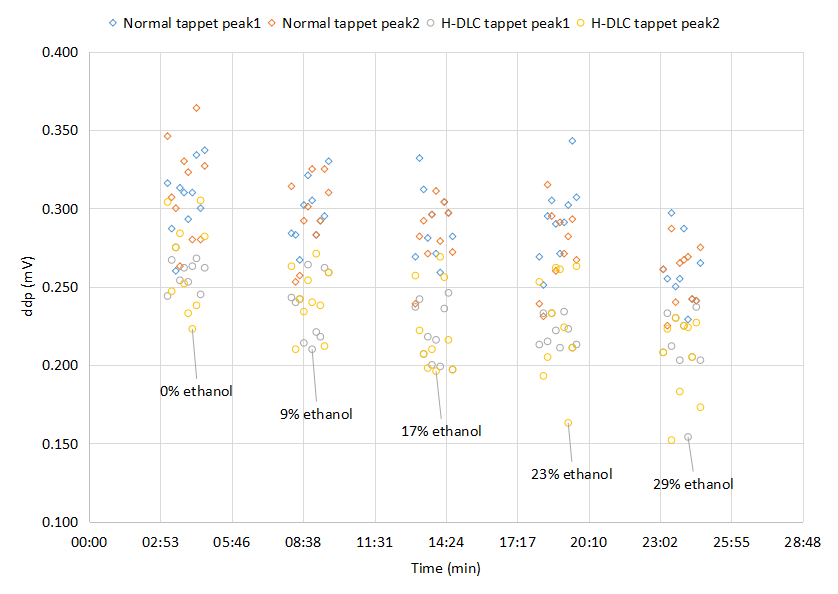Efeito dos revestimentos H-DLC nas forças de atrito came-tucho de ação direta
DOI:
https://doi.org/10.14295/vetor.v32i1.13417Palavras-chave:
H-DLC, Came-tucho, Trem de válvulasResumo
Nos motores de combustão interna, o trem de válvulas é responsável por até 25% das perdas por atrito em frequências rotacionais abaixo de 2000 rpm. Perdas importantes por atrito no trem de válvulas vêm do contato entre o came e o tucho. Apesar das especificações do fabricante para o lubrificante do motor, a viscosidade do lubrificante pode ser alterada em algumas condições, afetando as forças de contato came-tucho. Além disso, as condições da superfície do came e do tucho podem afetar essas forças de atrito. Este trabalho apresenta um aparato experimental de bancada monoválvula e resultados para investigações de força de atrito, utilizando lubrificante de motor envelhecido SN5W30, com modificações de viscosidade. A influência de uma coroa de tucho revestida com H-DLC é investigada, comparando com tucho padrão. Esses experimentos mostraram que, sob condições experimentais específicas, as forças de atrito entre o came e o tucho, quando o revestimento H-DLC é aplicado, são menores do que com o tucho padrão, para todas as viscosidades do lubrificante.
Downloads
Referências
Agência Nacional de Petróleo (in Portuguese), ANP. Available at: http://www.anp.gov.br/producao-de-derivados-de-petroleo-e-processamento-de-gas-natutal/producao-centrais-de-materias-primas-petroquimicas-cpq/gasolina.
K. G. Duleep, “The Benefits of Increasing Fuel Octane Number on Gasoline Engine Efficiency: A Literature Review,” SAE Technical Paper 2017-01-2237, 2017. Available at: https://doi.org/10.4271/2017-01-2237.
K. Holmberg and A. Erdemir, “Global Impact of Friction on Energy Consumption, Economy and Environment,” FME Transactions, vol. 43, no. 3, pp. 181-185, 2015. Available at: https://doi.org/10.5937/fmet1503181H.
A. Ferrarese, “Anéis de Pistão de Baixo Atrito” (in Portuguese), Mahle Metal Leve, 2015.
B. S. Andersson, Paper XVIII (iii) Company Perspectives in Vehicle Tribology – Volvo, Editor(s): D. Dowson, C.M. Taylor, M. Godet, Tribology Series, vol. 18, pp. 503-506, 1991. Available at: https://doi.org/10.1016/S0167-8922(08)70168-8.
Wong, V. W. and Tung S. C, “Overview of automotive engine friction and reduction trends - Effects of surface, material, and lubricant-additive technologies,” Friction, vol. 4, no. 1, pp. 1-28, 2016. Available at: https://doi.org/10.1007/s40544-016-0107-9.
A. Gangopadhyay, D. G. McWatt, R. J. Zdrodowski, S. J. Simko, S. Matera, K. Sheffer, and R. S. Furby, “Valvetrain Friction Reduction through Thin Film Coatings and Polishing,” Tribology Transactions, vol. 55, no. 1, pp. 99-108, 2012. Available at: https://doi.org/10.1080/10402004.2011.636169.
A. R. Schamel, M. Grischke, and R. Bethke, “Amorphous carbon coatings for low friction and wear and bucket tappet valvetrains,” SAE Technical Paper 970004, 1997. Available at: https://doi.org/10.4271/970004.
L. A. Ratamero and V. Ventura, “Fuel Economy Sensitivity Analysis for DLC Coatings on Tappets,” SAE Technical Paper 36-0027, 2018. Available at: https://doi.org/10.4271/2018-36-0027.
A. Dyson and M. A. Naylor, “Application of the Flash Temperature Concept to Cam and Tappet Wear Problems,” Proceedings of the Institution of Mechanical Engineers: Automobile Division, vol. 14, no. 1, pp. 255-280, 1960. Availabe at: https://doi.org/10.1243/PIME_AUTO_1960_000_026_02.
M. Teodorescu, D. Taraza, N. A. Henein, and W. Bryzik, “Experimental analysis of dynamics and friction in valve train systems,” SAE Transactions, vol. 11, sec. 3 (Journal of Engines), pp. 1027-1037, 2002. Available at: https://doi.org/10.4271/2002-01-0484.
C. M. Engler-Pinto, L. de Nadai, and E. Martins, “Analysis of Oil Sump Contamination with Ethanol in Flex Fuel Engines after Crank and Warm-up,” SAE Technical Paper 2009-36-0117, 2009. Available at: https://doi.org/10.4271/2009-36-0117.
A. Gangopadhyay, E. Soltis, and M. D. Johnson, “Valvetrain friction and wear influence of surface engineering and lubricants,” Proceedings of the Institution of Mechanical Engineers, Part J: Journal of Engineering Tribology, vol. 218, no. 3, pp. 147-156, 2004. Available at: https://doi.org/10.1177/135065010421800302.
M. Calabretta, D. Cacciatore, and P. Carden, “Valvetrain Friction - Modeling, Analysis and Measurement of a High-Performance Engine Valvetrain System,” SAE International Journal of Engines, vol. 3, no. 2, pp. 72-84, 2010. doi:10.4271/2010-01-1492, 2010. Available at: https://doi.org/10.4271/2010-01-1492.
ABNT NBR 6601:2012, “Light road vehicles - Determination of hydrocarbon, carbon monoxide, nitrogen oxide, carbon dioxide and particulate material on exhaust gas,” (in Portuguese), 2012.
H. L. Costa and H. Spikes, “Impact of ethanol on the formation of antiwear tribofilms from engine lubricants,” Tribology International, vol. 93, part A, pp. 364-376, 2016. Available at: https://doi.org/10.1016/j.triboint.2015.09.021.

Downloads
Publicado
Versões
- 2022-07-29 (2)
- 2022-07-15 (1)
















